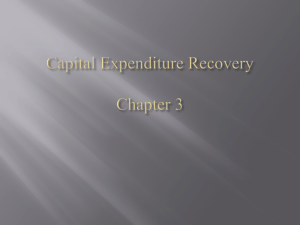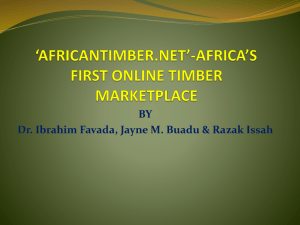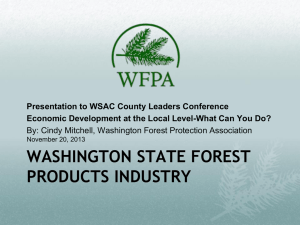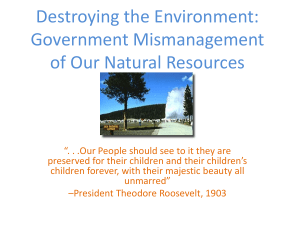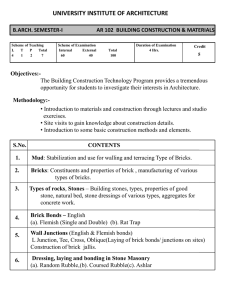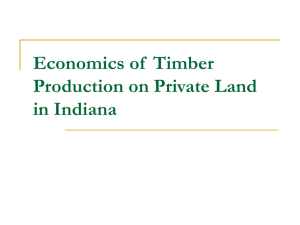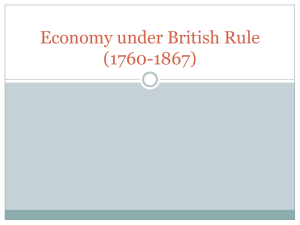Economics of Tree Farming - Oregon State University Extension
advertisement
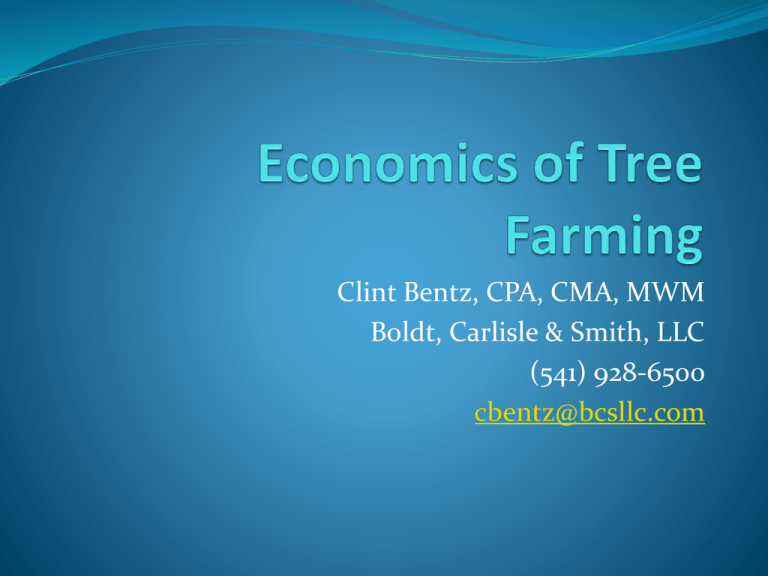
Clint Bentz, CPA, CMA, MWM Boldt, Carlisle & Smith, LLC (541) 928-6500 cbentz@bcsllc.com Overview What is Return on Investment? Financial and non-financial returns Accounting for your woodland Income & Estate tax issues Property tax programs Putting it all together to compute financial ROI Your family’s ROI What is Return on Investment? Payback period: No. of years to return your money Net Present Value: How much you will earn in today’s dollars over your target earnings rate Internal Rate of Return: Your earnings (interest) rate over the life of the investment Pre-or post tax calculation Effect of inflation Creating a model allows you to determine if certain investments pay off Financial & Non-financial ROI Top 10 reasons for owning family forests (2008 USFS survey): Enjoy beauty or scenery Family heritage Privacy Nature protection Connected to home or cabin Investment (6) Hunting or fishing Part of farm or ranch Hiking, snowmobiling, and other recreation Timber production (10) What is Highest & Best Use? Timber production? Recreation? Retreat? Development? Begin with the end in mind! (Steven Covey) An Intergenerational Affair Planting Harvest 1st Generation 2nd Generation 3rd Generation 4th Generation 5th Generation 1909 FORD Model T The Year 1909 Average Life Expectancy: 47 years 14% of homes had a bathtub 8% of homes had a telephone Model T invented – factory open in 1910 Only 8,000 cars and 144 miles of paved roads in the US. Tallest structure: Eiffel Tower @ 990’ Average wage: 22 cents/hour Average annual wage: $200-$400/yr No income tax, gas tax, or sales tax Over 95% of births were at home 90% of doctors had no college degree Women washed hair once/month Five leading causes of death (in order): Pneumonia & influenza Tuberculosis Diarrhea Heart Disease Stroke American flag had 45 stars 230 reported murders in the USA Population of Las Vegas, NV: 30 6% of Americans graduated from HS 20% of Americans illiterate No crossword puzzles, canned beer or ice tea (not invented yet) No Mothers or Fathers Day Cutting edge technology: Steam! 1910 Census – Percentage of Rural Households by State – Nat’l 53.85% The Year 1910 vs. 2010 US Population: 92million vs. 310m % living in rural: 54% vs. 16% Number in rural: 50m vs. 50m 2.5m farms, 10m woodland, 37.5m other 2012 Pew Research Study 53% of 18-24 year olds living with parents 29% of 25-34 year olds living with parents Highest % of multi-gen households since 1950’s What will the world be like in 2110? NEED TO STAY FLEXIBLE Pass on values and passion! Accounting for your Woodland Cost Basis of Land, Timber & Improvements Original purchase price allocated pro-rata Additional capital improvements and acquisitions Accumulated depletion & depreciation Annual income and expenses Check register Double entry accounting (debits = credits) Tax accounting and budgeting/planning purposes Timber growth and yield Income Tax Issues Depletion Computing taxes on sale of timber Passive Loss rules Reforestation Harvest & Privilege Tax Depletion Recovery of cost basis in timber Pro – rata over all components of value Example of Allocation ($350,000 purchase price): Assets Acquired Individual Value Percent of Total Allocated Basis Land 20,000 5% 17,500 Timber 200,000 50% 175,000 Residence 140,000 35% 122,500 Barn 20,000 5% 17,500 Reproduction 20,000 5% 17,500 Total 400,000 100% 350,000 Depletion Computed over all timber now standing Deduction computation example: Original basis allocated to timber $175,000 Timber standing before harvest 300 MBF Timber harvested during year 200 MBF or 67% Depletion deduction = $175,000 x 67% = $117,250 Remaining basis = $200,000 - $117,250 = $57,750 631(a) Election TIMBER OWNER LOG SELLER Stumpage value at Jan 1 Gross receipts less of harvested timber Less depletion deduction Net is Section 1231 capital gain from sale of business property Stumpage (COGS) Less operating costs Net is Ordinary income (loss) 631(a) Election 1231 Gain reported on 4797 transferred to Schedule D Ordinary income on Schedule C Recognize 631(a) gain in year timber is severed and measured. Must make election (Form T) on timely filed return Election is irrevocable. 631(a) Computation $200,000 gross proceeds from mill $150,000 “631(a) Value” (determined by appraisal) $117,500 depletion deduction $70,000 logging, hauling & operating costs Taxable income = $200,000 - $117,500 - $70,000 = $12,500 Schedule C Gross Sales 200,000 Sec 631(a) Cost/Gain (150,000) Depletion (cost basis) Form 4797 $150,000 (117,500) Logging & operating costs (70,000) Taxable Income (20,000) 32,500 Passive Loss Rules (1986 Tax Act) 60-100 years of losses, 1-5 years of income in business cycle. “Safe Harbor”: Income three years out of five. Three types of income: Active (wages, material participation business) Portfolio (interest, dividends, capital gains) Passive (rents, passive business) Losses from passive activities don’t offset other income Material participation is based on hours spent in the activity. Burden of proof is on the taxpayer. Assertion on tax return. 7 Material Participation Rules 1. 2. 3. 4. 5. 6. 7. 500 hour rule. Less than 100 hour rule. Between 100 and 500 hour rule. Multiple businesses rule (between 100-500 hrs). Five of last 10 years rule. Facts and circumstances rule. Personal service activity – N/A. Material Participation Rules Taxpayer and spouse time counts twice Interplay with 100-500 hour test Surviving spouse needs to meet “active management test” if farm Retired or disabled OK if material participant for 5 of 8 years preceding retirement/disability if farm Don’t have to meet same test each year Based on facts and circumstances – be careful! Need to keep a record of your hours! Reforestation Reforestation costs are capital costs, not available for depletion until first commercial entry Covers all costs to establish a forest (see Forest Practices Act for definition) Can elect to deduct up to $10,000 per year per Qualified Timber Property (on Form T) Can elect to amortize (Sec 194) amounts over $10,000 per calendar year for 7 yrs (with half year convention). Reforestation Cost share payments included in income ACP, FIP, ACP, EQIP pmts can be offset against costs based on formula State tax credit of 50% for conversion of underproductive lands. Program sunsets 12/31/2011. Discuss proposed project with stewardship forester first Site prep & planting done in 2011 Limited to commercial forestland not meeting minimum stocking requirements under FPA Harvest Tax Harvest tax levied on timber harvested on all land in Oregon. Due by January 31. Pay by 12/31 to deduct. If expect to owe $1,500 or more, must pay estimates. First 25 MBF harvested annually exempt Convert tons to MBF Loads where <10% of logs are 8” or larger divide tons/11 Loads where 10%+ are 8” or larger divide tons/7.5 Chips from dead trees divide tons/5 Chips from green trees divide tons/11 Rate for 2011 and 2012 is $3.575 per MBF Small Tract Forestland Program STF initiated in 2004. Land assessed at 20% of forestland value. Apply with county assessor by April 1 Must own at least 10 acres and less than 5,000 acres Must put entire tax lot and contiguous tax lots into program. Includes lands owned as individual and through entity ownership where you have majority interest. 2011 severance tax rates: WO $4.74/mbf, EO $3.70/mbf 10 year lookback/recapture if leave program Forest Resource Trust Reforestation assistance program Loan, not a grant – up to 100% financing, up to $100,000, secured by trees planted No harvest requirement, paid back at harvest as percentage of net proceeds. Catastrophic events and law changes preventing harvest cancel contract. Estate Tax Federal Exemption 2011, 2012 = $5 million + 35% Federal lifetime gift & GST exclusion also $5 million Oregon law changed in 2012: True exemption of $1 million Tax rates from 10-16% Three year statute of limitations Revised Oregon Natural Resource Credit NRP must be 50% of estate, total estate < $15 million NRP includes farm, forestry & fishing business NRP includes up to additional 15% in cash Annual reporting for dispositions & replacements, 5 years Computing ROI See Excel Model 2 4 8 16 32 64 126 Family Csn Owners Csn Uncle Mom Csn Wife Dtr Csn Aunt GM Dad GD Son Mgr Emp Emp Employees Outlaw HEIRLOOM SCALE 1 5 Where are you today on this scale? Why? (There is no “right” answer) 10 Family – Business Continuum Business as social welfare program for the family What is good for the business is good for the family Family most important, business must serve needs of the family Business most important, family must serve needs of the business TRUE ROI Growing timber is an intergenerational exercise Sharing Passion and Vision with the next generation Identify financial and non-financial values Create intergenerational ownership structure Create intergenerational family structure Communicate! Avoid the bear trap syndrome!

